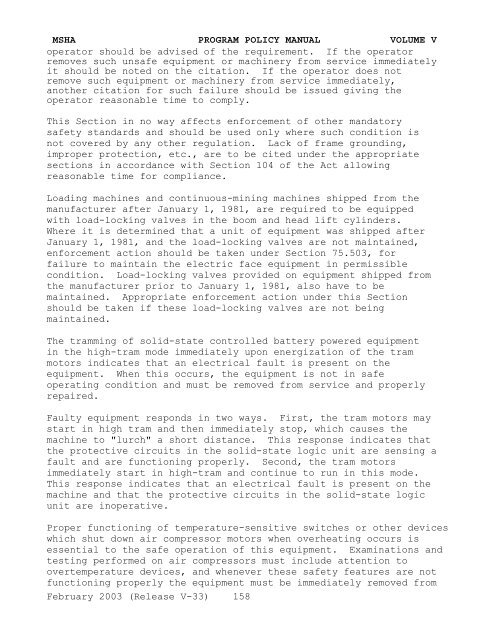Program Policy Manual - VOLUME V - Mine Safety and Health ...
Program Policy Manual - VOLUME V - Mine Safety and Health ...
Program Policy Manual - VOLUME V - Mine Safety and Health ...
You also want an ePaper? Increase the reach of your titles
YUMPU automatically turns print PDFs into web optimized ePapers that Google loves.
MSHA PROGRAM POLICY MANUAL <strong>VOLUME</strong> V<br />
operator should be advised of the requirement. If the operator<br />
removes such unsafe equipment or machinery from service immediately<br />
it should be noted on the citation. If the operator does not<br />
remove such equipment or machinery from service immediately,<br />
another citation for such failure should be issued giving the<br />
operator reasonable time to comply.<br />
This Section in no way affects enforcement of other m<strong>and</strong>atory<br />
safety st<strong>and</strong>ards <strong>and</strong> should be used only where such condition is<br />
not covered by any other regulation. Lack of frame grounding,<br />
improper protection, etc., are to be cited under the appropriate<br />
sections in accordance with Section 104 of the Act allowing<br />
reasonable time for compliance.<br />
Loading machines <strong>and</strong> continuous-mining machines shipped from the<br />
manufacturer after January 1, 1981, are required to be equipped<br />
with load-locking valves in the boom <strong>and</strong> head lift cylinders.<br />
Where it is determined that a unit of equipment was shipped after<br />
January 1, 1981, <strong>and</strong> the load-locking valves are not maintained,<br />
enforcement action should be taken under Section 75.503, for<br />
failure to maintain the electric face equipment in permissible<br />
condition. Load-locking valves provided on equipment shipped from<br />
the manufacturer prior to January 1, 1981, also have to be<br />
maintained. Appropriate enforcement action under this Section<br />
should be taken if these load-locking valves are not being<br />
maintained.<br />
The tramming of solid-state controlled battery powered equipment<br />
in the high-tram mode immediately upon energization of the tram<br />
motors indicates that an electrical fault is present on the<br />
equipment. When this occurs, the equipment is not in safe<br />
operating condition <strong>and</strong> must be removed from service <strong>and</strong> properly<br />
repaired.<br />
Faulty equipment responds in two ways. First, the tram motors may<br />
start in high tram <strong>and</strong> then immediately stop, which causes the<br />
machine to "lurch" a short distance. This response indicates that<br />
the protective circuits in the solid-state logic unit are sensing a<br />
fault <strong>and</strong> are functioning properly. Second, the tram motors<br />
immediately start in high-tram <strong>and</strong> continue to run in this mode.<br />
This response indicates that an electrical fault is present on the<br />
machine <strong>and</strong> that the protective circuits in the solid-state logic<br />
unit are inoperative.<br />
Proper functioning of temperature-sensitive switches or other devices<br />
which shut down air compressor motors when overheating occurs is<br />
essential to the safe operation of this equipment. Examinations <strong>and</strong><br />
testing performed on air compressors must include attention to<br />
overtemperature devices, <strong>and</strong> whenever these safety features are not<br />
functioning properly the equipment must be immediately removed from<br />
February 2003 (Release V-33) 158
















